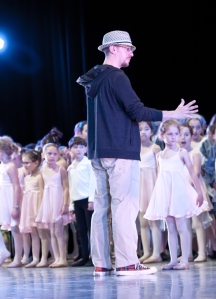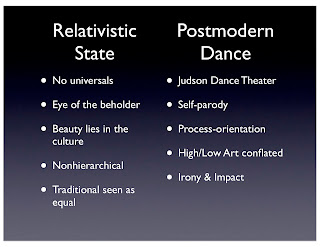Dance Paradigms (Part 2: E-C Theory in a Nutshell)
I am going to boil down Graves' Emergent, Cyclical Theory of Human Existence (what a foreboding title) to three main ideas for understanding dance and artistic movements/eras/paradigms.
1. Motivations Change
1. Motivations Change
Graves proposes that there is not one set of motivations and needs that we humans live by. Rather, that our motivations and needs evolve as we mature because “humans tend normally to change their biopsychosocial being as the conditions of their existence change” (Graves 507). Perspectives and worldviews shift as we evolve; the absolutist viewpoint of the medieval Catholic Church has shifted over time into a pluralistic viewpoint that allows for a variety of interpretations. As our understanding of the world and our thinking develops, so too does our understanding of art.
2. Develop Through States
2. Develop Through States
Graves research suggests humans psychologically develop through states of existence and “that each system has a general theme for existence which typifies it” (507). These systems develop  hierarchically from Automatic to Tribalistic to Egocentric to Absolutistic to Multiplistic to Relativistic to Systemic to Intuitive and beyond.
hierarchically from Automatic to Tribalistic to Egocentric to Absolutistic to Multiplistic to Relativistic to Systemic to Intuitive and beyond.
3. Apply Across Scale These states of existence and their progression were found in his research to not only apply on the scale of the individual’s psychosocial development, but also at the larger scale of humans as a species. The states parallel human societal development from pre-historic tribal ages to feudal ages to medieval times the industrial modern age to the postmodern age and beyond (Wilber 40). For me, the seeming parallel between Graves’ framework of value systems and the artistic paradigms from Traditional to Popular to Classical to Modern to Postmodern and beyond deserves further inquiry and discussion. And, it leads me to three main questions to ponder:
 hierarchically from Automatic to Tribalistic to Egocentric to Absolutistic to Multiplistic to Relativistic to Systemic to Intuitive and beyond.
hierarchically from Automatic to Tribalistic to Egocentric to Absolutistic to Multiplistic to Relativistic to Systemic to Intuitive and beyond. 3. Apply Across Scale These states of existence and their progression were found in his research to not only apply on the scale of the individual’s psychosocial development, but also at the larger scale of humans as a species. The states parallel human societal development from pre-historic tribal ages to feudal ages to medieval times the industrial modern age to the postmodern age and beyond (Wilber 40). For me, the seeming parallel between Graves’ framework of value systems and the artistic paradigms from Traditional to Popular to Classical to Modern to Postmodern and beyond deserves further inquiry and discussion. And, it leads me to three main questions to ponder:
- Can this information help me become a more insightful teacher? (After all, this began as a very personal inquiry.)
- Is the parallel between Graves’ framework and art movements consistent?
- Can this build a bridge of understanding between art and dance movements?
Beck, Don Edwards & Cowan, Christopher C. Spiral Dynamics. Massachusetts: Blackwell, 2006.
Graves, Clare W. The Neverending Quest. California: ECLET, 2005.
Martin-Smith, Keith. “On the Future of Art and Art Criticism.” Integral World. N.p. N.d. Web. November 6, 2009.
Wilber, Ken. A Brief History of Everything. Boston: Shambala, 2000.
Wilber, Ken. A Theory of Everything. Boston: Shambala, 2001.



Comments
Post a Comment